The last days I’ve been hard at work to polish up and finish releases of benchee (0.6.0 – Changelog), benchee_csv (0.5.0 – Changelog) as well as the initial releases of benchee_html and benchee_json!
I’m the proudest and happiest of finally getting benchee_html out of the door along with great HTML reports including plenty of graphs and the ability to export them! You can check out the example online report or glance at this screenshot of it:
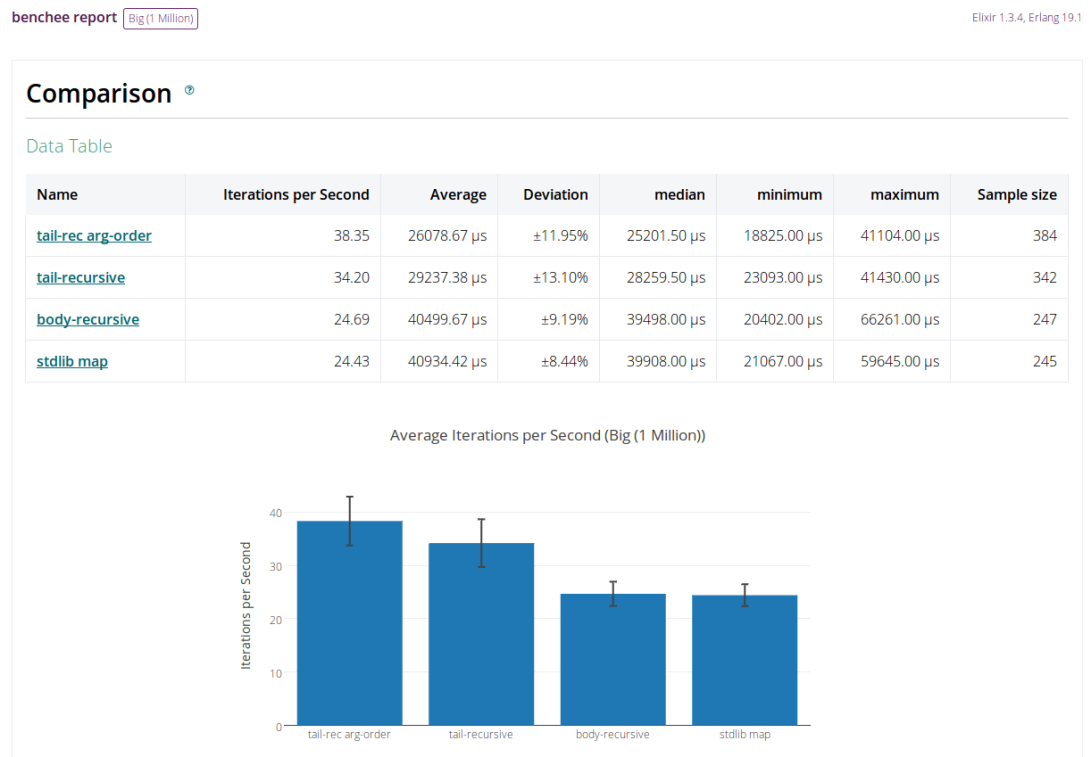 While benchee_csv had some mere updates for compatibility and benchee_json just transforms the general suite to JSON (which is then used in the HTML formatter) I’m particularly excited about the big new features in benchee and of course benchee_html!
While benchee_csv had some mere updates for compatibility and benchee_json just transforms the general suite to JSON (which is then used in the HTML formatter) I’m particularly excited about the big new features in benchee and of course benchee_html!
Benchee
The 0.6.0 is probably the biggest release of the “core” benchee library with some needed API changes and great features.
New run API – options last as keyword list
The “old” way you’d optionally pass in options as the first argument into run as a map and then define the jobs to benchmark in another map. I did this because in my mind the configuration comes first and maps are much easier to work with through pattern matching as opposed to keyword lists. However, having an optional first argument already felt kind of weird…
Thing is, that’s not the most elixir way to do this. It is rather conventional to pass in options as the last argument and as a keyword list. After voicing my concerns in the elixirforum, the solution was to allow passing in options as keyword lists but convert to maps internally to still have the advantage of good pattern matching among other advantages.
This file contains bidirectional Unicode text that may be interpreted or compiled differently than what appears below. To review, open the file in an editor that reveals hidden Unicode characters.
Learn more about bidirectional Unicode characters
| list = Enum.to_list(1..10_000) | |
| map_fun = fn(i) -> [i, i * i] end | |
| Benchee.run(%{ | |
| "flat_map" => fn -> Enum.flat_map(list, map_fun) end, | |
| "map.flatten" => fn -> list |> Enum.map(map_fun) |> List.flatten end | |
| }, | |
| formatters: [ | |
| &Benchee.Formatters.HTML.output/1, | |
| &Benchee.Formatters.Console.output/1 | |
| ], | |
| html: [file: "samples_output/flat_map.html"], | |
| ) |
The old style still works (thanks to pattern matching!) – but it might get deprecated in the future. In this process though the run interface of the very first version of run, which used a list of tuples, doesn’t work anymore 😦
Multiple inputs
The great new feature is that benchee now supports multiple inputs – so that in one suite you can run the same functions against multiple different inputs. That is important as functions can behave very differently on inputs of different sizes or a different structure. Therefore it’s good to check the functions against multiple inputs. The feature was inspired by a discussion on an elixir issue with José Valim.
So what does this look like? Here it goes:
This file contains bidirectional Unicode text that may be interpreted or compiled differently than what appears below. To review, open the file in an editor that reveals hidden Unicode characters.
Learn more about bidirectional Unicode characters
| map_fun = fn(i) -> [i, i * i] end | |
| Benchee.run(%{ | |
| "flat_map" => fn(input) -> Enum.flat_map(input, map_fun) end, | |
| "map.flatten" => fn(input) -> input |> Enum.map(map_fun) |> List.flatten end | |
| }, | |
| inputs: %{ | |
| "Small" => Enum.to_list(1..1000), | |
| "Bigger" => Enum.to_list(1..100_000) | |
| }) |
This file contains bidirectional Unicode text that may be interpreted or compiled differently than what appears below. To review, open the file in an editor that reveals hidden Unicode characters.
Learn more about bidirectional Unicode characters
| Erlang/OTP 19 [erts-8.1] [64-bit] [smp:8:8] [async-threads:10] [hipe] [kernel-poll:false] | |
| Elixir 1.3.4 | |
| Benchmark suite executing with the following configuration: | |
| warmup: 2.0s | |
| time: 5.0s | |
| parallel: 1 | |
| inputs: Bigger, Small | |
| Estimated total run time: 28.0s | |
| Benchmarking with input Bigger: | |
| Benchmarking flat_map… | |
| Benchmarking map.flatten… | |
| Benchmarking with input Small: | |
| Benchmarking flat_map… | |
| Benchmarking map.flatten… | |
| ##### With input Bigger ##### | |
| Name ips average deviation median | |
| map.flatten 139.35 7.18 ms ±8.86% 7.06 ms | |
| flat_map 70.91 14.10 ms ±18.04% 14.37 ms | |
| Comparison: | |
| map.flatten 139.35 | |
| flat_map 70.91 – 1.97x slower | |
| ##### With input Small ##### | |
| Name ips average deviation median | |
| map.flatten 18.14 K 55.13 μs ±9.31% 54.00 μs | |
| flat_map 10.65 K 93.91 μs ±8.70% 94.00 μs | |
| Comparison: | |
| map.flatten 18.14 K | |
| flat_map 10.65 K – 1.70x slower |
The hard thing about it was that it changed how benchmarking results had to be represented internally, as another level to represent the different inputs was needed. This lead to quite some work both in benchee and in plugins – but in the end it was all worth it 🙂
benchee_html
This has been in the making for way too long, should have released a month or 2 ago. But now it’s here! It provides a nice HTML table and four different graphs – 2 for comparing the different benchmarking jobs and 2 graphs for each individual job to take a closer look at the distribution of run times of this particular job. There is a wiki page at benchee_html to discern between the different graphs highlighting what they might be useful for. You can also export PNG images of the graphs at click of a simple icon 🙂
Wonder how to use it? Well it was already shown earlier in this post when showing off the new API. You just specify the formatters and the file where it should be written to 🙂
But without further ado you can check out the sample report or just take a look at these images 🙂
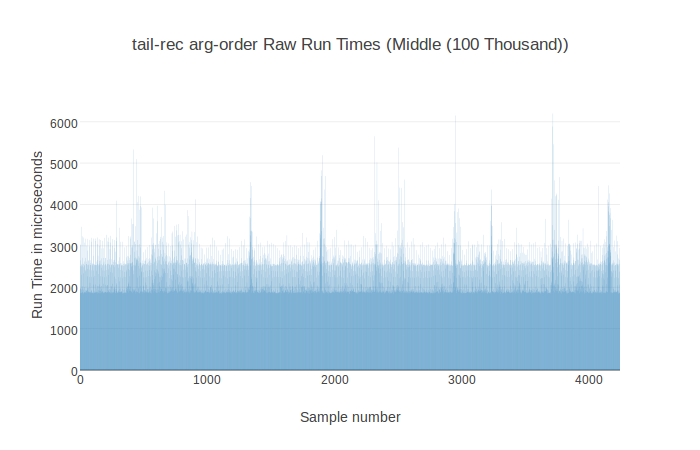 Closing Thoughts
Closing Thoughts
Hope you enjoy benchmarking, with different inputs and then see great reports of them. Let me know what you like about benchee or what you don’t like about it and what could be better.
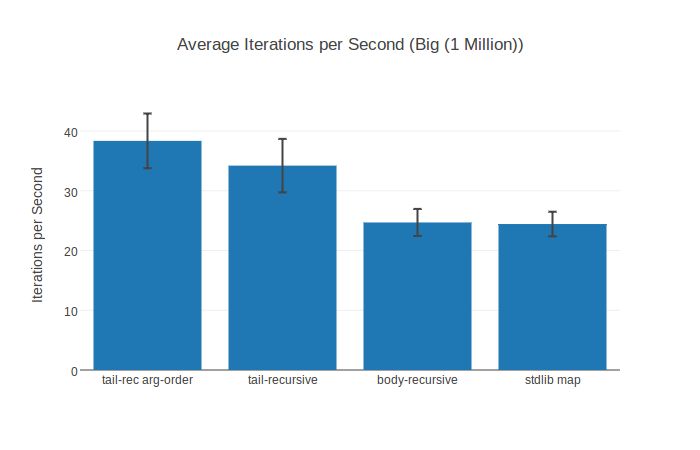
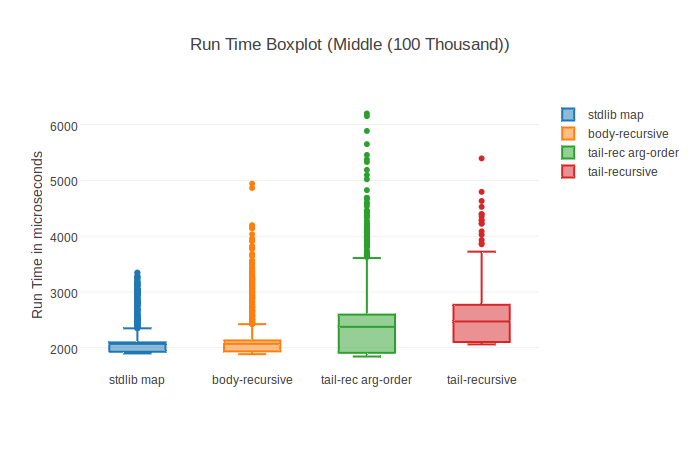
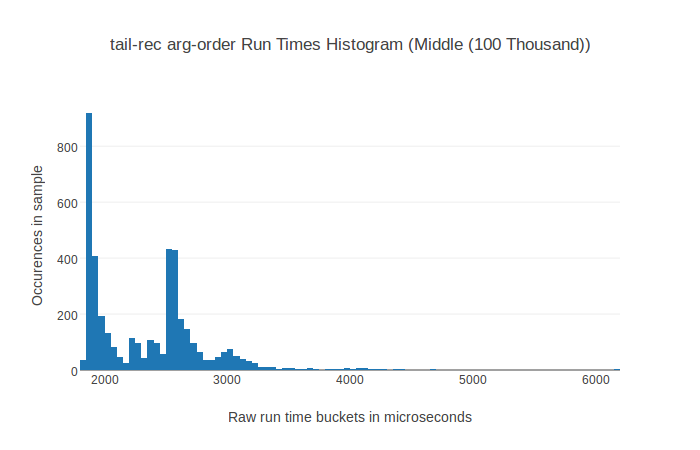
One thought on “Released: benchee 0.6.0, benchee_csv 0.5.0, benchee_json and benchee_html – HTML reports and nice graphs!”